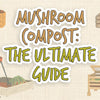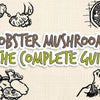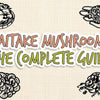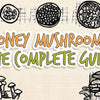Button Mushrooms: The Complete Guide
You have probably heard the name button mushroom get thrown around more times than you would care to count and of course, we all know mushrooms are nutrient packed and offer a healthy source of proteins and carbs. But just how much do you know about your local groceries favorite mushrooms? This guide will seek to uncover everything that you need to know about button mushrooms.
Not Much Time? Skip To What You'd Like To Learn...
-
Button Mushroom Facts
-
Types of Agaricus Bisporus
-
7 Health Benefits of Button Mushrooms
-
How to Identify Button Mushrooms
-
Acknowledging False Lookalikes
-
Foraging for Button Mushrooms
-
Growing Button Mushrooms at Home
-
Cleaning Button Mushrooms
-
How to Store Button Mushrooms
-
Considerations, Guide to Cooking and Recipes

Button Mushroom Facts

-
Button mushrooms scientific name is Agaricus Bisporus
-
They are the most widely cultivated mushroom throughout the world
-
The species was first cultivated back in France around the year 1700
-
Various strains of button mushrooms have been discovered most notably being the commercial white variety that we usually see in stores
-
The white button mushroom was discovered in 1926 by a farmer when he spotted the white caps in his brown bisporus mushroom bed
Types of Agaricus Bisporus

-
White Button Mushrooms: The white button mushroom is the classic grocery store mushroom, and it has a characteristic whitish creamy hue.
-
Cremini Mushrooms: The cremini mushroom is a brown strain and was the most common before the discovery of the white button. This variety has dark flesh with a brownish hue. Cremini's are also known by other names such as the Italian mushroom, brown mushroom, baby Bella and baby portobello.
-
Portobello Mushrooms: The portobello is a fully mature cremini.
7 Health Benefits of Button Mushrooms

-
Promote Weight Loss: Mushrooms are low in fat and therefore are highly recommended for weight loss. They are also high in energy, 100 grams of raw white button mushrooms contains 93 kilojoules of energy. This is mainly in the form of carbohydrates (3.26g), sugars (1.98g) and fat (0.34g). (link)
-
Rich in Protein: Button mushrooms contain up to 3g of protein for every 100g serving. This provides a healthy protein alternative and is why mushrooms are often used as a meat replacement. (link)
-
Excellent Source of B Vitamins: B vitamins play a vital role in cell metabolism. Button mushrooms can provide up to 19% of the daily value of B vitamins. These are B vitamins and how they help us:
- Riboflavin: Necessary for healthy cell growth.
- Pantothenic Acid: Involved in the synthesis and metabolism of proteins and carbohydrates.
- Niacin: Maintaining a healthy nervous system. (link)
-
Natural Source of Phosphorus: Button mushrooms are a good source of phosphorus. Phosphorus plays a pivotal role in the formation of healthy bones and teeth enamel. (link)
-
Rich Source of Vitamin D: Vitamin D is critical in facilitating the immune system function and maintenance of healthy development as well as the growth of bones. It's important to note that most of our body's vitamin D is produced during exposure to the sunlight, but mushrooms do offer an alternative supplement. (link)
-
Immune System Boost: Mushrooms contain certain trace elements that go a long way in enhancing the body's immune system especially in its fight against microbes such as bacteria and viruses. (link)
-
Lowering Cholesterol: Some of the vitamins in button mushrooms help in the balancing of cholesterol in the bloodstream. That added to the fact that mushrooms do not contain any cholesterol ensures that your body is able to maintain healthy levels of cholesterol thus minimizing your chances of suffering from heart attacks, atherosclerosis, and stroke. (link)
Summary (link)
How to Identify Button Mushrooms

Sight: Fresh button mushrooms are usually creamy white in color, and the gills should be tightly closed.
- Gilled Hymenium: Button mushrooms have gills on the hymenium which is the tissue layer of hymenophore (the spore-bearing part).
- Caps: Their caps are convex, the hymenium is free, and the stipe has a ring.
- Spore Print: Their spore print is brown; this is the powdery deposit obtained when the spores of a mature mushroom start falling off.
Touch: Before picking the mushrooms, you should try to press the cap whereby fresh button mushrooms usually have a firm cap and springy gills.
Smell: Button mushrooms should not have an offensive odor in fact, fresh ones don't have any noticeable odor at all.
Acknowledging False Lookalikes
1. Destroying Angel (Amanita sp.)
Young button mushrooms can be confused with the deadly poisonous destroying angel species. However, the latter is distinguished by their cup at the base. They also have pure white gills as opposed to button mushrooms which have pinkish or brown gills. For this reason, it's always recommended to clear away debris and examine the presence or absence of a cup on the base of the mushroom before harvesting. Also, its recommended to at least cut open a sample and check the gills to identify their color. (link)
2. Agaricus Xanthodermus
The Agaricus Xanthodermus is an inedible mushroom that's mostly found in grassy areas across the world. One of its identifying characteristics is that it has an odor reminiscent of phenol. Also, the mushroom's flesh will turn yellowish when bruised making it easier to distinguish it from button mushrooms. (link)
3. Entoloma Sinuatum
This poisonous European species has a passing resemblance to young button mushrooms. However, it has yellowish gills that turn pinkish as it matures. Also, the mushroom lacks a ring near the upper end of the stock. (link)
WARNING: Never pick or eat wild mushrooms unless under the strict guidance of an expert.
Foraging for Button Mushrooms
Button mushrooms are extremely easy to harvest mainly due to their size. Nothing beats a mushroom foraging expedition but before you get your mushroom knife out and go hunting you need to consider a few things:
Country: Button mushrooms are cultivated in more than 60 countries across the globe. However, this fungus is native to grasslands in North America and Europe.
Climate: The mushroom usually blooms from late spring through to autumn following rainfall.
Environment: Button mushrooms are commonly found in fields as well as grassy areas especially in the presence of manure.
Once you find your button mushrooms you should always cut carefully to avoid disturbing the mycelium thus allowing future production. It is also recommended not to disturb new growth until its reached maturity stage.
When foraging we would always recommend using mushroom knife for ease of use, and a clean cut. Interested in mushroom knives? Click Here For The Complete Guide To Mushroom Knives.
Growing Button Mushrooms at Home
There are two approaches when it comes to growing button mushrooms. For starters, you can buy a ready-made mushroom growing kit, or you can set up a homemade mushroom farm.
It is important to mention that Agaricus is actually a secondary decomposer. What this means is that the mushroom requires other fungi to breakdown raw material before it can grow. This does introduce a new level of complexity to its farming process as you have to composite the raw materials before you can plant the mushrooms.
Growing Button Mushroom From A Pre-Built and Spawned Kit
Usually, these kits will ship with an instructions manual detailing what you need to do. It's important to note that the methodology does vary from one package to the other, but most do include a casing layer and colonized growing medium. After setting up the kit, all you have to do is water the medium as per the instructions. Mushrooms grown using spawned kits are usually ready for harvest in about 1-2 weeks.
Find out our Top 10 Mushroom Growing Kits of 2019 in our article here (link).
At Home Mushroom Garden:
Phase 1 Composting
Prepare the mushroom compost. This relies on aerobic bacteria which breakdown the raw materials. The compost must be aerated regularly to ensure the continued breakdown of matter. This phase should be carried out until the compost turns dark-brown in color which indicates caramelization.
Phase 2 Composting
This stage is all about pasteurization and reduction of ammonia levels in the compost. The compost should be loaded on to wooden trays and placed in a temperature-controlled environment. Steam should then introduced to heat the compost up to 66 degrees for up to 2 hours. This serves to eliminate any pests and insects that might be in the compost. Then the temperature needs to be brought down to around room temperature, and the compost allowed to settle until there's no ammonia smell. Ammonia is harmful to bisporus, so we rely on the microbes still in the compost to convert it to proteins.
Spawning
This is the introduction of bisporus onto the compost, it needs to be mixed thoroughly and watered.
Casing
Add a layer of soil 2 inches deep on to the colonized compost. The casing layer serves to provide moisture as well as support the fungi during the spawn growth.
Pinning
Induce pinning by reducing air temperature and carbon dioxide concentration. Pins are the knots of mycelium that usually reach the surface and develop into mushrooms.
Cropping
The mushrooms will grow in phases. It's important to note that production will dwindle as you harvest more crop cycles and you will need to change out the compost after around five cycles.
Want to know our Top 10 Mushrooms Growing Kits? We have a full and comprehensive guide to the best growing kits and considerations before buying one too! Check out our Top 10 Mushroom Growing Kits Here.
Cleaning Button Mushrooms

-
Brushing: If you are using a mushroom knife to harvest, then the chances are that it has an attached brush. Use the brush to clean away any dust or dirt that might be clinging on to the mushroom and remember to be gentle.
-
Wiping: Generally speaking, the bristles should be more than enough to take care of all the dirt, if not you can then use a soft damp paper towel to clean the mushrooms.
-
Rinsing: This is the last option in case you are unable to clean the mushroom using the previous methods. Rinse the mushrooms using cold water preferably under a running tap. Wipe them dry using dry paper towels. Avoid soaking in water as the mushrooms will absorb the water and most will get trapped in the gills rendering them soggy.
How to Store Button Mushrooms
Naturally, button mushrooms have a short shelf life. There are however a few ways you can use to maintain them for future use such as:
Refrigerating: Most notably would be storing them in a refrigerator whereby you can put the freshly picked mushrooms in an open bowl and cover with waxed paper.
Check out our article on how to store mushrooms here (link).
Sun Drying: Chop the mushrooms into halves or quarters and dry them out under the sun; this will reduce their moisture content making it possible to store them in the pantry.
Check out our article on how to dry mushrooms here (link).
Canning: Use a pressure cooker to adequately boil the mushrooms under pressure until fully cooked. Seal in a can. It's important to note that home canned mushrooms run the risk of causing botulism just like any other non-standard canning process.
Check out our article on how to can and pickle mushrooms here (link).
Considerations and Guide to Cooking

It is important to remember that button mushrooms are 90% water for this reason low heat is not recommended as the mushrooms will end up soggy. Instead, you should apply medium high temperature to ensure that the water evaporates quickly thereby getting a golden rich hue from the mushrooms.
Button Mushroom Recipes
Sautéed Button Mushrooms
Ingredients:
8 ounces button mushrooms
3 garlic cloves, minced
1 cup white wine
3 tbsp unsalted butter
3 tbsp extra virgin olive oil
3 tbsp chopped fresh parsley
Directions:
1. In a non-stick skillet heat the oil on medium-high heat. Add the mushrooms avoid tossing until they begin to caramelize.
2. Add the butter and toss, continue cooking until they attain a golden hue.
3. Season with salt and garlic. After 2 minutes of sautéing add the white wine.
4. Once the excessive liquids have evaporated garnish with parsley and serve immediately.
Portobello Sandwich
Inspired by AllRecipes (link)
Ingredients:
16 ounces portobello mushrooms, sliced
12 tsp dried rosemary
1 large onion, sliced thinly
1 cup roasted red peppers, chopped
4 ounces cheddar cheese
2 cloves garlic, minced
4 soft bakery buns
1/3 cup mayonnaise
2 tsp olive oil
2 tbsp balsamic vinegar
salt
Directions:
1. Heat the olive oil in a skillet over medium-high heat and add the mushrooms. Cook until soft.
2. Add rosemary and vinegar and cook until the mushrooms turn brownish. Remove the mushrooms and set them aside.
3. Add the onion into the pan and fry until they turn caramel in color.
4. Add the red peppers and cook until the mixture is heated through.
5. Arrange the mushrooms into two piles on a grill pan and top the piles with the onion mixture and 2 oz of cheese. Place a skillet cover over these piles to allow the cheese to melt.
6. Toast the hamburger buns.
7. In a separate bowl mix the mayo, salt, and garlic. Place the mayo mixture onto each half of the toasted buns.
8. Use a spatula to place the mushroom mixture on the bottom half buns carefully.
9. Top each bun with extra cheese and broil in an oven until the cheese has melted.
Curried Kale With Portobello Mushrooms
Inspired by Food Fitness Fresh Air (link)
Ingredients:
6 oz portobello mushrooms, sliced
3 garlic cloves
1 large onion
1 tbsp olive oil
1 lb kale, cut into strips and stems removed
1 cup of water
salt
2 tbsp curry powder
2 tbsp tomato paste
1 tbsp brown sugar
Directions:
1. In a large non-stick skillet heat the olive oil over medium-high heat.
2. Add onions and sauté for 2 minutes, add garlic and portobellos and cook until they turn golden brown.
3. Mix the tomato paste, brown sugar, salt, and curry powder in a small bowl and add to the skillet.
4. Reduce the heat and add the kale and water. Let the mixture cook until the kale is tender.







